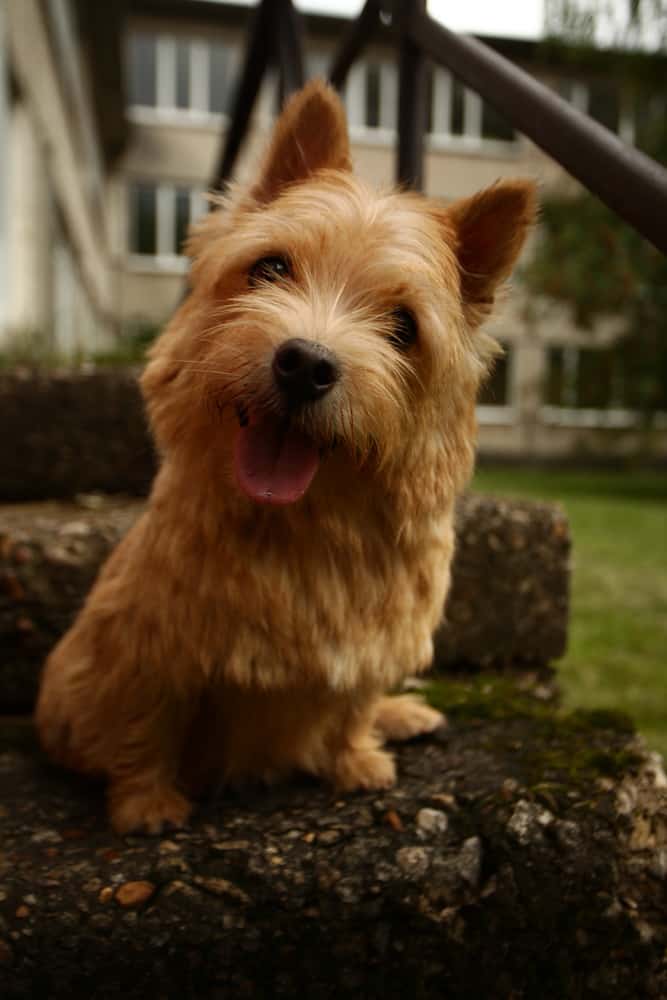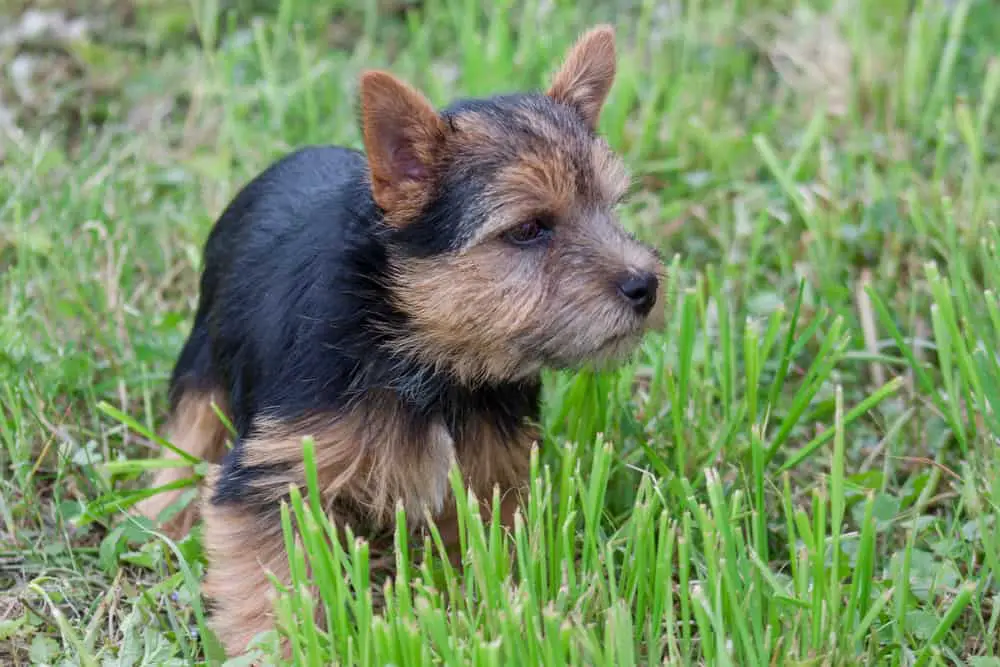Complete Guide To The Norwich Terrier: Grooming, Care, Health and More
The Norwich Terrier is tiny, but it’s no pampered pooch. Resembling Toto in The Wizard of Oz, these plucky 10-pound daredevils have a similar zest for life’s adventures.
I’ve had a handful of this breed come into my veterinary practice over the past 20 years and every single one of them has been a happy, sweet, intelligent dog. While I wish I saw more of them, I’m glad that the breed isn’t too overbred.
Table of Contents
How Big Do Norwich Terriers Get?
Norwich Terriers are small but stocky, weighing in at 12 pounds or less and standing 10 inches high. Males and females are generally the same size.
What Do Norwich Terriers Look Like?
Square-shouldered and well-balanced, they’d fit neatly in a basket. Their medium-length double coats are wiry and straight with an additional depth around the neck and shoulders forming a lion-like mane.
Colors include various shades of:
• Black and Tan
• Grizzle
• Red
• Wheaton
Their deep brown eyes are small, round and deep-set, giving them a keen gaze versus a pleading look. Ears are small, erect and pointed — tails are docked but not short. Their muzzles are compact but not squat and a perfect fit for their broad heads.
Norwich Terriers share their lineage with several similar breeds. They’re easily mistaken for the Australian, Cairn and Border Terriers and their close cousin, the Norfolk Terrier.

What Is The Personality Of A Norwich Terrier?
Terriers are affable as a group, but Norwich Terriers are delightfully brash. Athletic and outgoing, this breed has plenty of personality. Loyal and affectionate, they play hard, but they also like to cuddle, so plan on some evening couch time.
The Norwich is a good fit for active families — there’s nothing they’ll enjoy more than romps in the park with the kids. Small, they can be good apartment dogs, but they’ll bark at anything suspicious, so early socialization and training is a must to prevent nuisance barking. Bred to hunt, they retain their instinct to chase and require ample exercise in a secure area to channel their considerable energy.
How Much Grooming Does A Norwich Terrier Need?
Norwich terriers have a double coat featuring a short, wooly layer for warmth and a harsh outer coat that protects them from inclement weather. It’s thick, substantial and requires special care to keep it looking its best. Regular brushing removes dirt and debris, but hand-stripping is ideal for thinning the undercoat and maintaining its trademark texture.
Hand-stripping is a time-consuming but straightforward process any owner can handle. It requires plucking loose hair by hand or with a stripping knife. Clipping is faster, but the results simply aren’t comparable.
The good news is that many professional groomers have experience hand-stripping, yet the process is one owners and dogs can bond over. Do a little each day and save baths for when you’re done.
As with all breeds, regular ear and nail care are an essential part of grooming. Ears should be examined monthly and cleaned with a pH-balanced solution if they’re waxy or irritated. Clip their nails every three weeks to keep them at a safe length for playing outdoors.
How Much Exercise Does A Norwich Terrier Need?
They’re terriers so by nature they need a lot of exercise. Start with a daily vigorous 30 minute (minimum) walk. A vigorous walk isn’t a walk where your dog stops and sniffs every bush and tree that they pass. Walking is meant to be exercise so put your walking shoes on and treat it as such.
However, these dogs won’t need just a walk. They will demand more than that. A long session of fetching with a ball or toy or a fun, indoor play session with a toy will also be demanded by the Norwich.
One point – I don’t like tug of war games with this particular breed. The kind of stress that puts on the neck can lead to neck issues later in life as the discs in the spine degenerate.

What Kind Of Dog Food Is Best For Norwich Terriers?
Norwich Terriers require no special dietary considerations other than they tend to lean towards obesity as they get older (at least the dogs in my practice have). Because they’re already a small frame size, adding extra calories is easy by giving them high-calorie snacks and small bites of people food.
Before we start with the food lists, just know that grain-free dog foods are a myth. There’s zero science showing that they are helpful. In fact, there’s increasing evidence that it’s causing issues in certain breeds of dogs. Food allergies are the only reason to even consider a grain-free diet but only choose one with the help of your veterinarian.
Basic dog foods that I recommend include:
- Purina Pro Plan With Probiotics Shredded Blend
- Amazon Brand – Wag Dry Dog Food
- IAMS Minichunks Adult Dry Dog Food
- Blue Buffalo Wilderness High Protein With Grains
Over the Counter Weight Management Diets:
How Long Do Norwich Terriers Live?
12-15 years
What Health Problems Do Norwich Terriers Have?
While the Norwich is a hardly little breed, I do see the following health issues more commonly with them:
- Dental Disease
- Luxating Patella
- Obesity (so easy to overfeed these guys as they get older)
Where Can I Learn More About Norwich Terriers?
Norwich Terrier Club of America (NTCA)
Where Can I Find A Norwich Terrier?
Looking for a Rescue? Start with the NTCA Rescue/Rehoming Page
Interesting Facts About Norwich Terriers
Norwich Terriers come from a long line of similar dogs bred to hunt rats in plague-ridden Europe. But they have a unique history of their own and deserve special consideration.
Did you know?
• They’re Not Toys
It’s common for dogs as small as the Norwich to be called a toy breed, but there’s nothing pretend about this pup. Though pint-sized, they retain the fierce qualities of their terrier ancestors and remain part of the AKC’s Terrier Group.
• From Rags to Riches
The Norwich Terrier was once popular among the college crew at UK’s Cambridge University. Ownership was such a fad in the 1880s that dorms held as many dogs as students.
Acquired from a nearby livery stable on Trumpington Street, for a time, they were known as Trumpington Terriers. One particularly fine example, Rags, became a top breeder, siring high-quality litters that contributed significantly to the modern dog we know today.
• Coming to America
British roughrider Frank Jones was singularly responsible for introducing the Norwich Terrier to the United States. Enamored with Rags, he fine-tuned the breed, exporting a descendant named Willum to Philadelphia. So closely was Jones linked to the early development of the Norwich that even after they were recognized by the AKC, they were still affectionately called Jones Terriers.
• Norfolk or Norwich?
The Kennel Club of England accepted Frank Jones’ breed as the Norwich Terrier, named after their hometown in England. But there were once two varieties — a prick-eared and drop-eared — so confusion occasionally remains. The AKC clarified the issue in 1979, christening the prick-eared variety the Norwich and renaming the drop-eared type the Norfolk.
• Tails Can Stay Au Naturel
Norwich Terrier’s tails were once docked for protection. Dogs that chased prey down holes were often extricated by pulling on their tails, something most experts believed was safer when the length was docked.
But now that their hard-working days are over, most kennel clubs prefer they be shown with natural tails. Only the AKC favors docked lengths, although natural tails are not a disqualification. Other nations have banned docking entirely or limit it to working dogs.
